Solvents for oil paints and varnishes
Petrol... Is the most simple and
a widespread solvent that can be used for oil
paints. It is a clear liquid, which is better known as a fuel for
cars - has a high degree of inflammation and a characteristic odor.
It is obtained as a result of the distillation of oil. Mainly, gasoline is used in
as a solvent for oil paints and alkyd enamels, as well as varnishes and
putty. Less commonly, it is used to thin pentaphthalic enamels.
Besides,
additional functions are degreasing of surfaces for application
varnish or paint, as well as dry cleaning of fabrics and rinsing of parts and tools.
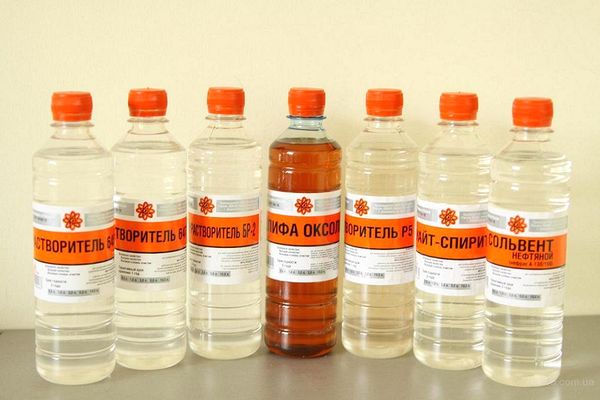
Turpentine... Also one of the solvents
for varnishes and paints. This solvent
is a complex mixture of hydrocarbons, mainly terpenes.
Turpentine is used as a solvent for oil and alkyd styrene
enamels and paints. Also, this substance is used for the preparation of many
lacquers based on copal, rosin and dammar. By the way,
remained, almost the only most common solvent, until
the moment of the appearance of white spirit.
White Spirit... Actually, now
let's talk about white spirit. This solvent is used as a substance
for thinning most paints - oil and enamel paints, varnishes and others
paint and varnish products. It is used to dilute a primer or varnish,
bituminous material, putty and auto preservatives, for washing hands and hands after
using paints, enamels and so on. Also used for degreasing
surface.
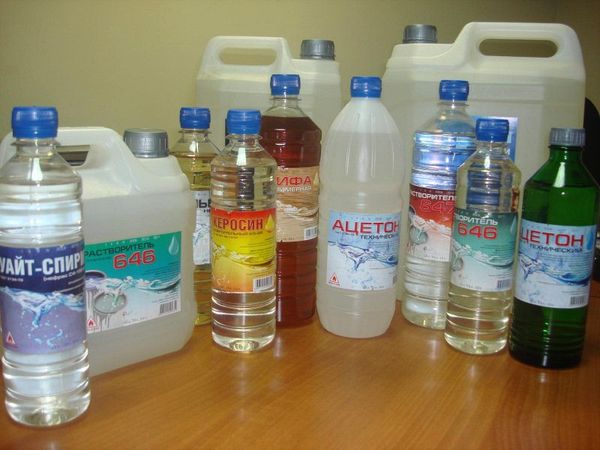
Characteristics of the metals that make up the driers
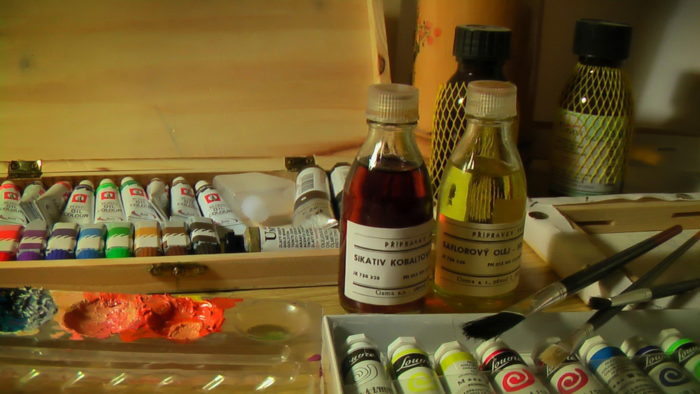
Desiccant for oil paints
Cobalt - considered the most effective, but the drying effect extends to the surface of the film. As a result, there is underfilm movement in thick layers of the coating, therefore it is rarely used alone (for very thin layers, in some baked paints).
Lead is a popular volumetric desiccant, toxic, and can form sulphide stains on the coating. It is practically not used independently.
Manganese acts both on the surface and in the bulk. The main disadvantage is the dark brown color of the trivalent state. In the manufacture, it is necessary to strictly adhere to the recipe, since an increase in the amount of manganese leads to the opposite effect.
The properties of zinc are that it slows down the drying rate of the coating surface, accelerating the volumetric and forming a solid film.
Calcium is used as a promoter in multi-part driers to improve drying at low temperatures.
Cerium and vanadium have a volumetric effect, but they give the film a yellowish tint.
Zirconium is increasingly recommended to be used instead of lead in compounds with cobalt due to its good bulk action and low toxicity.
Preparation method
Industrial
The industry uses two technologies for producing catalysts: "dry" and "wet". Manufacturing by the second method is a laborious process, but the obtained catalysts are of higher quality than the driers obtained by the "dry" method.
The essence of the dry method: metal oxides are added to rosin, naphthenic acids or vegetable oils. Moreover, any base must be heated or melted. As a result, metal salts are formed - soaps.
A significant disadvantage of this method is the partial destruction of compounds under the influence of high temperatures, which leads to the formation of solutions of metal oxides, a decrease in the efficiency and shade of the catalyst.And also, this process is considered fire hazardous due to the complexity of heat regulation and the formation of foam in large quantities.
In the wet method of manufacturing catalysts, salts of metals dissolved in water and abietic acids are used. When the salts dissolved in water are mixed, a desiccant is formed - a catalyst. The most common desiccants obtained in this way are naphthenates, metal desiccants.
At home
The recipe for making a desiccant with your own hands is not complicated. To obtain a catalyst for additives to paints and varnishes, resinates are used. 50 grams of rosin is placed in a metal or porcelain container, then melted at 250 degrees. It is necessary to stir the substance periodically, after complete melting, add a little quicklime. Then it is necessary to stir the solution until a homogeneous mass is obtained.
In the same way, you can make manganese oxide by calculating the amount of sodium sulfite and potassium permanganate. When they are mixed, a dark powdery precipitate is obtained, which must be filtered and thoroughly dried in air. In this case, it is extremely undesirable to heat it, since toxic gases are released into the air when heated.
Application features
The purchase of this additive is advisable for use with oil-containing paints, alkyd-type paintwork materials during their production and use. The additive promotes accelerated drying of coatings, shortening the dyeing time. NF-1 is used alone or in a mixture with cobalt-containing brands NF-4 and NF-5 to enhance the effect. It is necessary to mix the components in strict accordance with the instructions in order to avoid overdose (overdose).
The use of a hardener requires compliance with certain rules:
- The chemical is added to the paint and varnish in small portions.
- Its maximum concentration should not be exceeded: 5 g per 100 g of film former. Otherwise, the drying speed of the film may not only deteriorate, but also the shade of the color of the dye composition, especially light, may change.
- When using a hardener, be aware of its toxicity and potential to cause a fire. The skin of the hands, respiratory and digestive organs of the worker must be protected from the harmful effects of the chemical. Work should be carried out away from sources of open fire, heating devices in rooms with good ventilation and regular ventilation.
Using our advantageous offer to buy a hardener in bulk, keep an eye on the storage period and conditions. The guaranteed shelf life of the product is 6 months. If more has passed, before using the chemical, it is necessary to carefully check its effectiveness on a small amount of paint. Store in a sealed container in a room out of direct sunlight, heating and electrical appliances that could lead to a fire. Temperature range for transportation and storage: from -20 ° С to + 30 ° С.
Driers
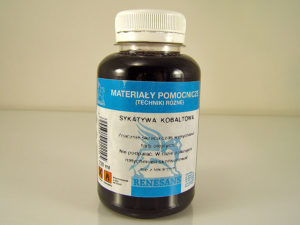
Desiccants (from Latin Siccativus - to dry) are auxiliary compounds that are introduced into oil paints to speed up the drying process. Chemically they are catalysts for the oxide polymerization of vegetable oils. Salts of cobalt, manganese, zirconium, barium, lead, calcium and the like can be used as desiccants.
Classification
According to the mechanism of action, driers are divided into two classes: primary, or true driers, and auxiliary (promoters), which have an activating effect on primary driers. Promoters promote uniform drying of the coating thickness and increase the stability of true driers.
True driers are salts of carboxylic acids of transition metals such as cobalt, manganese, lead, existing in two valence states.
The promoters include calcium, barium, zinc, and zirconium salts.The mechanism of action of promoters is that, being strong bases, they actively interact with the carboxyl groups of alkyd OLIGOESTER, excluding the interaction with them of metal salts that make up the driers.
Mechanism of action
Desiccants facilitate the transfer (transport) of O 2 air to the film former.
In this case, O2 interacts with methylene groups, which are in the α-position to the double bonds of unsaturated acids, with the formation of hydroperoxides ROOH.
In this process, salts of transition (Co, Mn) and non-transition (Pb, Ca) metals (less active Ni and Cu) are active. At the stage of initiation of radical polymerization, transition metals participate in the decomposition of hydroperoxides with the formation of radicals.
In addition to the catalytic action, desiccants improve the mechanical and protective properties of the coating, increase their hydrophobicity and corrosion resistance, are plasticizers and modifiers.
Co-based driers in combination with alkaline soaps ensure the rejection of water-borne paints and varnishes. Some compounds are cipher bases, amines, Azine, hydrazine, NH 3, etc.
- Promote the action of desiccants.
Receiving
In industry, desiccants are obtained in two ways. The most common precipitation method is based on an exchange reaction in an aqueous solution between a metal salt (sulfate, nitrate, acetate, carbonate) and an alkaline soap of the corresponding acid.
The method does not require heating to a high temperature and results in the formation of a high quality desiccant. Another production method is the fusion of oxides, hydroxides or salts (carbonates, acetates) of the metal with acids at 320-360 ° C, sometimes in the presence of a solvent to remove the reaction water.
Desiccants are also obtained by directly dissolving finely divided metals in heated acids or using electrochemical methods.
Toxicity
Heavy metals contained in most desiccants (cations of lead, manganese, cobalt, zinc, etc.) are toxic. Excessive contact with such substances can have harmful effects on the human body.
How to speed up paint drying
 All types of desiccants cause darkening of paints, the oil film loses its elasticity due to them, and the painting ages faster. Therefore, we use them only in the most necessary cases as additives in paints known for their slow drying (niello, kraplak and asphalt), and in underpainting, if there is not enough time for it to dry. In slowly drying paints, a desiccant is added already at the factories when rubbed, so that further addition is unnecessary.
All types of desiccants cause darkening of paints, the oil film loses its elasticity due to them, and the painting ages faster. Therefore, we use them only in the most necessary cases as additives in paints known for their slow drying (niello, kraplak and asphalt), and in underpainting, if there is not enough time for it to dry. In slowly drying paints, a desiccant is added already at the factories when rubbed, so that further addition is unnecessary.
Only small amounts of desiccants should be added to the pasty layers of paints so that they do not cause the fastest drying possible, since subsequently, as a result of too fast drying, a thin film would form on the surface of the layer, which would prevent the oxidation of the lower layers, and they would remain semi-liquid for weeks and months.
The painted surface would wrinkle and crack. In this respect, lead driers give better results than cobalt driers, as they tend to dry out the entire layer. This, of course, does not mean that the cobalt drier is less valuable; for a normal, not too thick layer of paints, on the contrary, it is most suitable. For technical drying oils and varnishes, combined desiccants of two metals, for example cobalt and manganese or cobalt and lead, are used to achieve the most intense drying, but such combinations are not recommended for painting.
TEST METHODS.
4.1. Sampling - in accordance with GOST 9980.2-86.
4.2. Sample preparation for testing
Stir the paint thoroughly before testing. The mass fraction of the film-forming substance and volatile substances, as well as the degree of grinding, is determined without diluting the paint.
To determine the rest of the indicators, paints are diluted to a paint consistency with drying oils in the amount of 20 - 30% for grades MA-015, MA-025 and 30 - 40% for grades MA-015 iron red lead, MA-015 mummy, MA-015 ocher from the thickened mass paints:
- paints MA-015, MA-015 iron red lead (mummy, ocher) - natural drying oil or combined K-3, K-5;
- paints of the MA-025 brand - Oksol linseed oil or combined K-2.
The diluted paints are filtered through a sieve with a mesh 056 N (GOST 6613-86) and applied with a brush to the prepared plates.
A desiccant of the NF-1 brand (GOST 1003-73) or the ZhK-1 brand is introduced into the paint made on ocher up to 2% by weight of the paint.
Plates for applying paints are prepared in accordance with GOST 8832-76, section. 3.
The color of the film, the drying time of the paint, the conditional lightfastness of the film and its resistance to the static effect of water are determined on plates made of steel grades 08kp and 08ps in accordance with GOST 16523-89 or from cold-rolled steel in accordance with GOST 9045-93 with a size of 70 ´ 150 mm and a thickness of 0.5 - 1.0 mm or on plates made of black sheet according to GOST 13345-85, 70 ´ 150 mm in size and 0.25 - 0.32 mm thick.
The hardness of the film is determined on special-purpose glass plates with a size of 90 ´ 120 mm and a thickness of 1.2 mm according to TU 21-0284461-058-90. To determine the color, the paint is applied until the substrate is completely covered and dried for 24 hours at a temperature of (20 ± 2) ° C.
To determine the drying time and hardness of the film, the paint is applied with a brush in one layer, to determine the conditional lightfastness of the film and the resistance of the film to static effects of water - in two layers. Each layer is dried for 24 hours at a temperature of (20 ± 2) ° C. When determining the conventional lightfastness of the film, the first layer is dried at a temperature of (20 ± 2) ° C for 24 hours, the second for 120 hours.
The coating thickness of a single-layer coating after drying should be 25 - 30 microns, two-layer - 50 - 60 microns.
4.3. The color of the dried paint film is determined by the method of visual comparison with the color of the corresponding color samples (standards) of the "Card of color standards" or control color samples under natural or artificial daylight diffused light.
The compared samples should be in the same plane at a distance of 300 - 500 mm from the observer's eyes at an angle of view that excludes the glitter of the surface. In case of disagreement in the assessment of color, the result is taken to determine the color in natural daylight.
4.2, 4.3. (Modified edition, Amendment No. 1).
4.4. The mass fraction of the film-forming substance in the paint is determined according to GOST 17537-72. Acetone (GOST 2768-84) or a mixture of acetone with ethyl alcohol (GOST 17299-78) in a ratio of 3: 2 by volume is used as a solvent.
4.5. The mass fraction of volatile substances is determined according to GOST 17537-72. A sample weighing 1.5 - 2.0 g is placed in an oven and kept at a temperature of (140 ± 2) ° С. The first weighing is carried out after 1 hour of exposure in the cabinet, and the subsequent ones - every 30 minutes until a constant weight is reached.
It is allowed to determine the mass fraction of volatile substances under an infrared lamp at a temperature of (140 ± 2) ° С.
In case of disagreement in the assessment of the mass fraction of volatile substances, the final result is determination in the drying oven.
4.6. (Deleted, Amendment No. 1).
4.7. The conventional lightfastness of the film is determined according to GOST 21903-76, method 3.
It is allowed to use lamps of the PRK-2 or DRT-375 brands. The distance of the samples from the surface of the lamps should be (350 ± 5) mm. The steady state of the lamp should be as follows: voltage (120 ± 6) V, current (3.75 ± 0.25) A.
The irradiation of the film is carried out for the time specified in clause 8 of the table. 2.
Irradiated samples are examined with the naked eye and compared to non-irradiated samples. Slight loss of paint film gloss and slight discoloration are allowed.
(Modified edition, Amendment No. 1).
4.8. The resistance of the film to static water exposure is determined in accordance with GOST 9.403-80, section. 2. Samples are placed in distilled water (GOST 6709-72) and kept in it for the time specified in clause 9 of the table. 2. After testing, the samples are kept in air at a temperature of (20 ± 2) ° С for 2 hours and the appearance of the film is examined.
After testing, the film should not flake off, wrinkle and have bubbles. Slight loss of gloss and slight discoloration of the film is acceptable.
Sparingly soluble desiccants
Lead acetic acid belongs to such driers.It can be obtained as a result of an elementary chemical reaction when lead interacts with acetic acid. It can be purchased in the form of crystals. To introduce this desiccant into the oil, lead sugar must be heated to one hundred degrees. This allows water to be removed from the substance. The substance dissolves at a temperature of 200-220 degrees.
Lead hydroxide is a yellow powder. For dissolution, it requires heating to 210-215 degrees.
Red lead is another of the hard-to-dissolve driers. The substance is an orange powder. Its dissolution temperature is 200-220 degrees. Lead-based driers are poisonous and bad for health
Special precautions are required to handle them. Do not allow harmful substances to get inside the respirators, and wash your hands thoroughly.
This is especially important when pouring substances and when grinding them. A respirator must not be neglected, hands must be clean
Another desiccant containing manganese is pyrolusite. It is a natural product and is a black powder. The substance will be more effective with a higher content of manganese oxide. Pyrolusite dissolves when heated to 250 degrees Celsius.
Cobalt acetic acid belongs to hardly soluble desiccants. It looks like a red powder. The substance contains 30% cobalt.
Preparation method
In industry, there are two production methods - wet and dry. When using the wet method, precipitates are obtained. Fused are obtained by dry method. You can also make it yourself at home. It is enough to purchase the necessary components.
Industrial
As stated above, there are two ways in industry. Let's consider them in more detail. Wet (precipitated) - produce substances of the highest quality. They are widely used. This is the main production method of the product. The entire chemical reaction takes place in a solution of water. No thermal action is required.
Dry - Fused dryers are formed. Oil, rosin, acids are added to metal oxides.
At home
To make it yourself at home, you must have:
- containers made of porcelain or metal;
- 50 grams of rosin.
We heat the rosin in a container at 250 degrees. Stirring constantly or periodically. The rosin should be completely melted. Then add a small amount of slaked lime. Mix everything thoroughly until smooth. As soon as the mixture becomes transparent, burning stops.
Production of desiccants
Generally speaking, one should distinguish between two main methods of obtaining desiccants. These are dry and wet modes. The dry method makes it possible to obtain fused desiccants, the wet method makes it possible to release the precipitated desiccants.
The wet method is much more difficult. However, it provides the best quality of the substance. This provided him with wider application. Today, driers are mainly produced by the sedimentation method.
The dry method involves the introduction of metal oxides into molten rosin, naphthenic and other acids. Desiccants can be added directly to the oil. At a sufficiently high temperature, metal salts are formed - soaps.
The disadvantage of dry desiccants is the destruction of organic substances as a result of the technological process. This can result in less effective substance and discoloration. Among other things, the process of making fused desiccant is associated with a significant risk of fire. This is due to the difficulties in regulating the temperature regime and increased foaming.
What is a desiccant in paints for, types and technical characteristics

The ability, with the help of fillers and additives, to significantly change the characteristics of paints and varnishes, gives manufacturers a wide range of opportunities to vary the formulation depending on the conditions and scope of application.The end customer may not be worried about the composition of the coating, what property is given to the paint by this or that additive, but there are situations when the consumer wants to influence the properties himself, and in this case need to know what the component must be used to change the characteristics. To accelerate the chemical curing of oil-containing film-formers, a special catalyst, a desiccant, is used.
Usage Tips
The calculation of the amount of desiccant that needs to be added to the PF-060 alkyd varnish for effective hardening ranges from 2 to 7%. With the introduction of such an additive, the drying time is limited to 24 hours. This result is achieved even with the abandonment of lead-containing preparations in favor of more modern technological solutions, which are still met with distrust by many. The shelf life of driers in most cases is six months.
Important: recommendations for the introduction of a desiccant do not apply to any ready-made mixtures in principle. Already in production, the required amount of all substances was initially introduced there, and if not (the product is of poor quality), it will still not work to assess the problem and fix it at home.
In relation to the film former, you can add from 0.03 to 0.05% cobalt, from 0.022 to 0.04% manganese, from 0.05 to 2% calcium and from 0.08 to 0.15% zirconium.

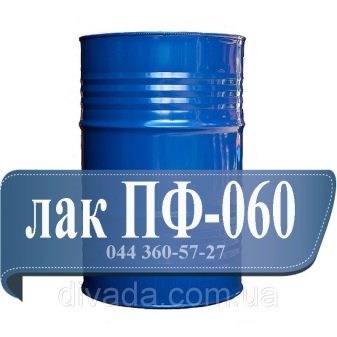
In the presence of soot, ultramarine and some other components in the coloring matter, the surface effect of the desiccant is weakened. This can be dealt with by the introduction of increased doses of the drug (both immediately and in separate portions, more detailed recommendations can only be given by a qualified technologist).

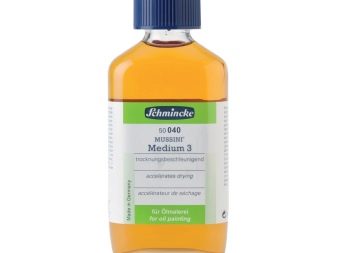
How to use a drying oil drier, see the next video.
Classification of driers and their types
The classification is based on the origin of organo acids:
- naphthenates;
- linoleates;
- rubbery;
- talats.
They are also divided into types according to the method of production:
- Fused - the manufacturing method is simple. Under thermal action, oils and resins are fused with a combination of metals.
- Precipitated - are made in the process of chemical action on metal compounds with salts acids. Light color mixture. It contains an active metal.
Desiccant lcd 1 specifications
Fatty acids consist of a solution of salts of polyvalent metals in various fatty acids and their mixtures with naphthenate acids in an organic solvent. Used for alkyd paint and varnish enamels and linseed oil. The mixture (liquid) is transparent.
Specifications. The share of non-volatile components is 25%. The amount of manganese is up to 1.5%, lead is up to 6%. Mixed with linseed oil without haze. Considered flammable and toxic.
Desiccant nf 1 composition and application
They are added to oil and alkyd enamels. Combines with paintwork materials in small portions. Dosage, ratio is indicated on the package. The drier is 5% of the total mass of the paint and varnish material. Manufactured in accordance with GOST 1003-73.
Desiccant NF-1
Popularity of goods NF-1:
- High quality and competitive prices.
- Flexible system of discounts and bonuses
- Individual approach to each client
- Timely and convenient delivery to any region of Russia
Desiccant NF-1 is an effective hardener that provides the fastest drying of painted surfaces. It is added to oil and alkyd paints, enamels, varnishes and varnishes. It looks like a transparent homogeneous liquid without sediment and impurities. It can be used with cobalt desiccants of the NF-4, NF-5 brands. The desiccant NF-1 is mixed with paints and varnishes according to the instructions for use, while the dosage should not exceed 5% of the total mass of the film former.
Desiccant NF-1 is a hardener based on lead-manganese naphthenate. The mass fraction of the first metal is 4.5-5%, the second - 0.9-1.3%, non-volatile substances - no more than 32%. White spirit or linseed oil can be used as a solvent. The result should be a clear liquid without sediment.
If necessary, the desiccant NF-1 is used with older brands of hardeners: NF-4 and NF-5. During work, it is required to use protective equipment for the skin, respiratory and digestive organs. It is also recommended to ensure fire safety and adequate ventilation. The flash point of the composition is at least 33 ° C.
The company "Khimprom-M" is a direct manufacturer of paintwork materials, therefore it can guarantee the quality of supplied products and low prices. The NF-1 desiccant being sold is delivered across Russia. You can make a purchase online by clicking on the "Order" button. To find out more about the NF-1 desiccant or other paintwork materials and related compositions, contact the consultants at the numbers listed at the top of the page.
Application of desiccant NF-1
It is used both independently and in mixtures with desiccants of the NF-4 and NF-5 brands to accelerate the drying of paints and varnishes.
No more than 5 g of composition per 100 g of paints and varnishes
Desiccant NF-1 is a solution of lead-manganese naphthenate in white spirit.
Store desiccant NF-1 in a hermetically sealed container, away from heating devices and electrical devices, protect from direct sunlight. Transportation and storage at temperatures from -20 ° С to +30 ° С is allowed.
Guaranteed shelf life of desiccant NF-1
This section of the site contains reviews of our clients. Many delight us with official letters, and someone leaves them on the site. If you also want to leave a review about our production, use the special form.
This is a universal hardener and is often used in our production, so we order in large quantities, and even at a discount to our company. We like Khimprom-M products, they are always of high quality and it is easy and pleasant to work with them. The main thing is to observe safety measures. The consumption is relatively small, the price is very suitable for us.
Of all the hardeners available, we most often order this one.
It really significantly speeds up the drying of almost all paints and varnishes, which is important for us, since we often have to perform work in damp rooms. This hardener saves us time and money
The only thing is that you have to be careful when using it, as it is quite toxic, and so - only pluses.
Name: Nikolaev | Date of publication: July 18, 2014, 2:21
We often order this drier in large quantities. We work with painting various elements in the construction industry and in the automotive industry. The drier has very good properties. Thanks to him, we speed up work twice, and sometimes even three times.
Delivery is carried out by road, container, rail transport throughout Russia, as well as abroad. Sending groupage cargo by transport companies at the request of the client and self-pickup. We carry out delivery to the transport company free of charge!
